More Hot News
'BRAIN DAMAGE CAN MAKE YOU BRILLIANT'
The October 2006 issue of Discover magazine featured
an article on the Centre's research into the mind's hidden skills. Click here to read the article.
'GET SMARTER'
The 10 October 2006 issue of The Bulletin magazine featured
an article on The Centre's research into the mind. Click
here to read the article.
2020 - A VISION FOR THE NATIONS' FUTURE. PART 1: TOMORROW'S WORLD
Professor Allan Snyder's vision for 2026 appeared in Part 1 of The Australian special feature 2026 - A Vision for
the Nation's Future on 28 October
2006. In it, he predicted the use of "thinking caps"
that will change the way we think and the way we see the world. Click here to read the article.
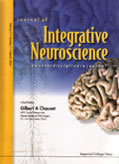 SEX-BASED RECOGNITION OF ANGRY FACES SEX-BASED RECOGNITION OF ANGRY FACES
According to new research just published in the Journal of
Integrative Neuroscience, angry male faces are processed
in the opposite side of the brain to angry female faces. The Centre for the Mind has found that the brain’s
response to male angry faces are processed by the left hemisphere,
while angry female faces are processed by the right hemisphere.
Only females participated in the study. Click
here to read the paper.
'MAGNETIC FIELD' CAN BOOST BRAIN
London's Daily Telegraph of 8 June 2006 featured an
article on the Centre's latest research on savant-like numerosity
skills. Click here to read the article.
ACCESS YOUR INNER RAIN MAN
The Centre's latest published research on savant-like numerosity
skills is featured in an article in The Sydney Morning Herald of 5 May 2006. Click here to read
the article. Professor Snyder was also interviewed on ABC Radio
Newcastle's Morning Show regarding this research.
RESEARCH PAPER PUBLISHED IN PERCEPTION
The Centre's latest research on "savant-like numerosity
skills revealed in normal people by magnetic pulses" has
been published in Perception in its 2006 issue, vol 35, pp. 837
- 845. Click
here to read the paper.
 EXPEDITION INS GEHIRN - VOYAGE INTO THE BRAIN EXPEDITION INS GEHIRN - VOYAGE INTO THE BRAIN
Allan Snyder features in a 3-part German-made documentary, discussing
his research into the mind's hidden skills. The documentary will
be widely screened throughout Europe on Arte, ARD, 3Sat and Phoenix
in February, March, April and May 2006 and has been licenced to
several more countries.
'THE CONTROVERSIAL PROFESSOR'
Malaysia's national The Star newspaper of 5 February
2006 features an article on Allan Snyder, with excerpts from his
graduation address "What Makes Extraordinary Success?"
to the Canberra Grammar School of December 6, 2005. Click
here to read the article.
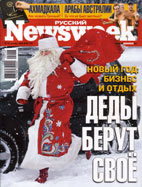 RUSSIAN NEWSWEEK PROFILES THE CENTRE'S RESEARCH RUSSIAN NEWSWEEK PROFILES THE CENTRE'S RESEARCH
Russian Newsweek of 19-25 December 2005 profiles the
Centre's latest research into savant-like skills, via an interview
with the Centre's Director, Professor Allan Snyder.
INVITED ADDRESS TO THE BOSTON CLUB
On 8 December 2005, Professor Snyder presented "A Possible
Push Pull TMS Therapy for Autism", to an elite assembly of
autism experts at the Nancy Lurie Marks Family Foundation's Boston
Club meeting.
INTERVIEW FOR BBC RADIO 4, 9 NOVEMBER 2005
Allan Snyder is interviewed on the nature of scientific frontiers
for a series aired on the UK's BBC Radio 4.
'ONE IN A MILLION': SUN-HERALD AND SUNDAY AGE ARTICLE
The Sun-Herald of 6 November
2005 features Allan Snyder in an article on the nature of
genius. This article also appeared in the Sunday Age on the same date.
NEW SCIENTIST SPECIAL ISSUE ON CREATIVITY
The New Scientist Creativity issue of 29 October 2005
features Allan Snyder and his tips on how to become more creative.Click
here to read the article.
INTERVIEW WITH BBC RADIO 4, AIRED 30 AUGUST 2005
Allan Snyder is interviewed about creative genius for a 3 part
series on creativity aired on the UK's BBC Radio 4.
CENTRE'S RESEARCH TELEVISED WORLDWIDE, 16 AUGUST 2005
Discovery Channel is again rescreening the popular Savants documentary which features the Centre's research
on creativity and nonconscious skills. Savants was
first televised across America in January 2003 on the Discovery
Channel. Since then it has been screened internationally. The
response from viewers was overwhelming, and the program is continually
rescreened worldwide, most recently in September 2003 and March
2004.
MALAYSIAN SAVANT PING LIAN VISITS THE CENTRE FOR THE MIND
Autistic savant artist Yeak Ping Lian visited the Centre to meet
with Allan Snyder in June 2005, bringing some of his artwork. For more information on Ping Lian, visit his website at www.pinglian.com
'BEAUTIFUL MINDS OFTEN HARDEST TO MANAGE'
In the Australian Financial
Review of 26 July 2005 (p.59), Professor Snyder says
employers can get the best from their most intelligent workers
by encouraging them to take risks and confront conventional wisdom.
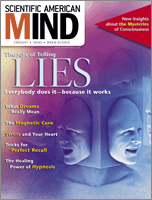 LATEST DISCUSSION OF THE CENTRE'S WORK IN SCIENTIFIC AMERICAN LATEST DISCUSSION OF THE CENTRE'S WORK IN SCIENTIFIC AMERICAN
There have been a number of stories mentioning our work in the
Scientific American over the years. The latest appears in the
June 2005 issue of Scientific American Mind in the article
'A Great Attraction". To view the article, go to the Scientific
American website.
'GENIUS AT WORK: A LOBE OUT OF LOOP'
Cover story: The Canberra Times Panorama magazine of
26 March 2005. Features a story on Professor Snyder's research
into creativity, championship and accessing the mind's hidden
skills. Click here to read
the article.
THE AUSTRALIAN FINANCIAL REVIEW: 'WINDMILLS OF THE MIND'
The 11 March 2005 issue of The Australian Financial Review features an article on the savant Daniel Tammet, quoting Professor
Snyder's suggestion that he could be the "Rosetta Stone". Click here to read the article.
'BRIGHT MINDS PUT SYDNEY UNDER THE SPOTLIGHT'
Cover story: The Sydney Morning Herald's the (sydney)
magazine of 23 February 2005 features Allan Snyder as one of "six
of our best thinkers and opinion-makers [who] discuss what they
most admire about Sydney, and suggest some timely improvements". Click here to read.
THE GUARDIAN WEEKEND: 'A GENIUS EXPLAINS'
The Guardian's story of 12 February 2005 discusses Professor
Snyder's views on the extraordinary savant, Daniel Tammet: "'Savants
can't usually tell us how they do what they do,' says Snyder.
'It just comes to them. Daniel can. He describes what he sees
in his head. That's why he's exciting. He could be the Rosetta
Stone.' Snyder, for instance, believes that we all possess the
savant's extraordinary abilities". Read
on
'THE DAY MY BRAIN WAS TURNED OFF BY A MAGNET'
In the UK's The Daily Telegraph of 24
January 2005, science reporter Roger Highfield "wanted
to investigate claims by Professsor Allan Snyder...who believes
TMS can act as a creativity-amplifying machine".
 50 AUSTRALIANS WHO REALLY MATTER (TO THE REST OF THE WORLD) 50 AUSTRALIANS WHO REALLY MATTER (TO THE REST OF THE WORLD)
The Sydney Morning Herald's Spectrum
cover story of 22-23 January 2005 singles out Professor Allan
Snyder as one of the "Australians who really matter (to the
rest of the world)" - one of those who "have made the
world a different place". This article also appeared in Melbourne's The Age newspaper
of 22 January 2005.
JAPANESE DOCUMENTARY 'POWER OF MEMORY', 23 NOVEMBER 2004
Japanese NTV airs the documentary Power of Memory, featuring
an interview with Professor Allan Snyder.
MARCONI AWARD CEREMONY - BOLOGNA ITALY, OCTOBER 2004
Larry Page and Sergei Brin, 2004 Marconi Prize winners for the
invention of the Google search engine, together with 2001 Marconi
winner Allan Snyder in Bologna, Italy.
THE CREATIVITY QUOTIENT: AN OBJECTIVE SCORING OF IDEATIONAL FLUENCY
The Centre's invention of a unique information theoretic measure
of a person's creativity quotient was published in the Creativity
Research Journal in August 2004. This is an integral part
of our corporate creativity and innovation program.
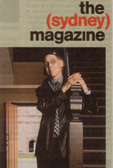 SYDNEY'S BRIGHTEST MINDS SYDNEY'S BRIGHTEST MINDS
The Sydney Morning Herald of 25 August 2004 features Sydney's
Brightest Minds, amongst them Professor Allan Snyder.
LET ME SLEEP ON IT
The Centre's research into Nonconscious
idea generation was published in the June 2004 issue of Psychological
Reports.
Striking accounts attest to the existence of nonconscious idea
generation - the "let me sleep on it" phenomenon. We
quantify this with a novel methodology. After participants ran
out of ideas on one task, they were actively engaged on another.
Then we resumed the first task. A significant number of new ideas
were generated after the distracting break, suggesting that our
mind continues working on an old question whilst being engaged
on a new one.
CENTRE'S RESEARCH FEATURED ON AMERICA'S ABC 20/20 PROGRAM
The 28 May 2004 edition of America's top rated TV news magazine,
ABC's 20/20, featured Professor Snyder's research on
the thinking cap - scientific ways to amplify creativity and to
access the mind's hidden skills. Finding
Your Inner Genius.
PROFESSOR ALLAN SNYDER INTERVIEWED ON CNN
Professor Allan Snyder appeared on CNN's Anderson Cooper
360 show in an interview on the brain. The segment aired
in the U.S. on Wednesday 19 May 2004 at 7:00pm.
CHINA'S MODERN WEEKLY INTERNATIONAL
The 1 May 2004 edition of China's Modern
Weekly International featured a story on Professor Snyder's
research into creativity and accessing the mind's hidden skills
(untranslated).
"LEARNING HOW TO TAP INTO GENIUS"
The Centre's research into creativity is profiled
in a Sunday Telegraph feature on 25 April 2004.
"BRAIN PULSE MACHINE TO UNLOCK THE GENIUS WITHIN"
The 15 April 2004 edition of The Sydney Morning
Herald features an article on Professor Snyder's research
into creativity. Click
here to read the article.
"BRAIN MACHINE - INSTANT GENIUSES"
The Herald Sun profiles the Centre's research
on tapping into hidden genius in its 3 April 2004 issue.
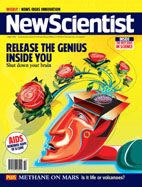 NEW SCIENTIST COVER STORY NEW SCIENTIST COVER STORY
The 3April 2004 edition of New Scientist features
a cover story, The
Genius Machine, on Professor Allan Snyder and his research into creativity.
ALLAN SNYDER'S RADIO APPEARANCES, APRIL 2004
Allan Snyder conducted two radio interviews this month. On 1
April, he was interviewed by BBC National, discussing the Centre's
Thinking Cap. On 2 April, he was interviewed by 666 ABC Radio
Canberra's Rod Quinn for the Drive program.
'GENIUS MACHINE'
England's The Sun newspaper of 1 April
2004 featured the Centre's research in it's article 'Genius Machine'.
More Hot News
|

